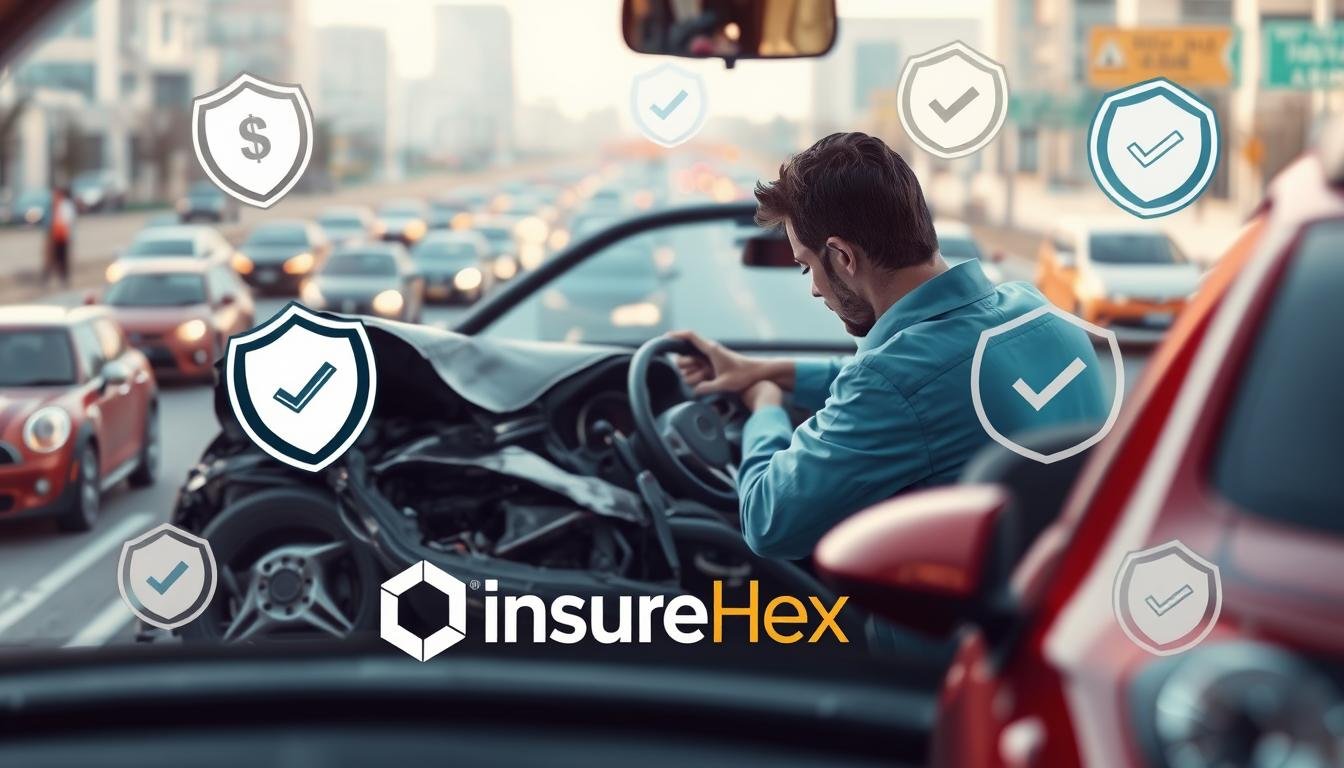In the United States, over 4 million car accidents happen every year. Many of these are caused by the drivers themselves. These accidents can lead to serious injuries, damage to property, and huge financial costs. But, drivers can protect themselves by knowing about different insurance options and safety measures.
Key Takeaways
- Importance of personal injury protection to cover medical expenses and lost wages
- Understanding uninsured and underinsured motorist coverage to protect against negligent drivers
- Liability insurance as a critical safeguard for drivers found at fault in an accident
- Specialized policies like rideshare driver insurance and occupational accident insurance
- Steps to mitigate driver negligence and file claims effectively
We want to help drivers understand how to deal with self-inflicted accident insurance and protection. Whether you drive daily, work as a rideshare driver, or operate a commercial vehicle, knowing your insurance options is crucial. It can help you avoid financial disaster and ensure a secure future.
Understanding Self-Inflicted Accidents
Self-inflicted accidents happen when a driver causes an accident by their own actions. This can include distracted driving, speeding, or driving under the influence. These accidents can lead to serious legal and financial problems for the driver.
Types of Self-Inflicted Accidents
There are many types of self-inflicted accidents. These include:
- Distracted driving, such as using a cell phone, eating, or adjusting the radio while driving.
- Speeding or reckless driving, where the driver goes too fast or drives dangerously.
- Impaired driving, which means driving after using alcohol, drugs, or other substances that affect judgment and reaction time.
- Fatigued or drowsy driving, where the driver is too tired to drive safely.
Legal Implications and Liability
Self-inflicted accidents can lead to serious legal and financial issues. The driver might face charges like driver negligence, liability, or even criminal charges. They could also be responsible for paying for any damages or injuries, including medical costs, property damage, and legal fees.
| Type of Accident | Legal Implications | Financial Liability |
|---|---|---|
| Distracted Driving | Fines, license suspension, or criminal charges | Responsible for all damages and injuries |
| Speeding or Reckless Driving | Fines, license suspension, or criminal charges | Responsible for all damages and injuries |
| Impaired Driving | Fines, license suspension, or criminal charges (DUI) | Responsible for all damages and injuries |
| Fatigued or Drowsy Driving | Fines or license suspension | Responsible for all damages and injuries |
Drivers need to know the risks and consequences of self-inflicted accidents. This knowledge helps them make safe choices and avoid legal and financial problems.
The Importance of Personal Injury Protection
As drivers, we must focus on our safety and financial health. Personal injury protection (PIP) is key in this area. It covers medical costs, lost wages, and more, no matter who’s at fault.
PIP offers many benefits. It helps with:
- Medical expenses for injuries, like hospital bills and therapy.
- Lost wages if you can’t work because of the accident.
- Important services like childcare and transportation that you can’t do anymore.
With PIP, drivers know they’re protected after an accident. It eases the worry of medical bills and lost income. This lets the driver focus on healing and getting back to driving safely.
“Personal injury protection is a vital safeguard for responsible drivers, offering peace of mind and financial security in the event of a self-inflicted accident.”
Getting PIP is a smart move for any driver. It’s part of a driver safety insurance plan. It gives the needed coverage and peace of mind after an accident.
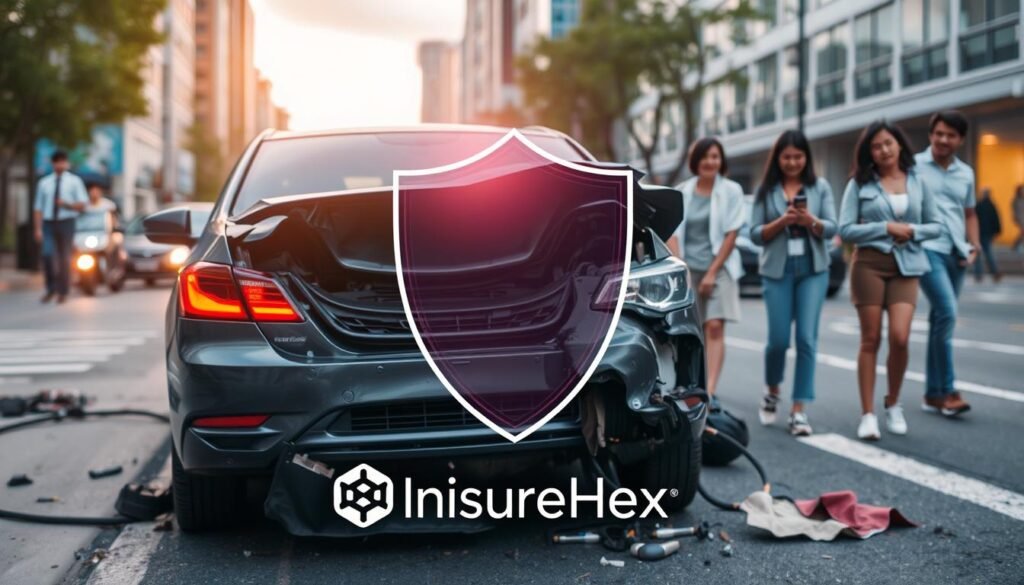
Uninsured and Underinsured Motorist Coverage
Dealing with the aftermath of an accident caused by yourself can be tough. But uninsured motorist coverage and underinsured motorist coverage can help a lot. These options protect you when the other driver doesn’t have enough or any insurance.
How Uninsured Motorist Coverage Protects You
When the driver who caused the accident has no insurance, uninsured motorist coverage kicks in. It helps pay for your medical bills, lost wages, and other damages. This way, you don’t have to pay for someone else’s mistake.
The Benefits of Underinsured Motorist Coverage
Underinsured motorist coverage helps when the other driver’s insurance isn’t enough. It gives you the extra money you need to cover your medical costs and other losses. This keeps you safe from the financial stress of a non-fault accident.
| Coverage | Key Benefits |
|---|---|
| Uninsured Motorist Coverage |
|
| Underinsured Motorist Coverage |
|
Knowing about uninsured motorist coverage and underinsured motorist coverage helps you prepare for accidents. It’s a smart move to protect yourself.
Liability Insurance for Drivers
Liability insurance is key for drivers to protect themselves from accidents. It helps cover costs if someone else gets hurt or their property is damaged. Most states require drivers to have this insurance, making it a must-have.
Liability insurance has different needs for commercial and rideshare drivers. Commercial policies have higher limits because business driving is riskier. Rideshare drivers need special coverage that works during both work and personal time.
| Coverage | Personal Auto Insurance | Commercial Auto Insurance | Rideshare Driver Insurance |
|---|---|---|---|
| Liability Limits | Typically lower | Typically higher | Varies, often bridges the gap |
| Accident Protection | Limited to personal use | Covers business-related driving | Covers both personal and rideshare driving |
| Coverage Exclusions | May exclude commercial use | Typically broader coverage | Designed for rideshare-specific needs |
Having the right liability insurance for drivers is vital. It protects you from the costs of accidents. Knowing what each policy offers helps drivers get the right coverage for their needs.
Self-inflicted accident insurance for drivers
Standard auto insurance might not cover all risks on the road. Drivers can face serious legal and financial issues from self-inflicted accidents. Luckily, there are special insurance policies to help protect them.
Driver safety insurance offers more than personal injury protection. It covers a range of self-inflicted accident scenarios. This insurance can help pay for medical bills, lost wages, and other costs. It’s key to know what each policy covers.
Occupational accident insurance is great for those who drive for work, like delivery drivers. It covers injuries from work-related driving, including self-inflicted ones. This helps protect both the driver and their employer.
“Protecting ourselves on the road is crucial, and specialized insurance policies can provide an extra layer of security in the event of a self-inflicted accident.”
Drivers should check their current coverage and understand the risks. They should also look into these special insurance options. Taking steps to protect themselves can reduce financial and legal problems from accidents.
In summary, self-inflicted accident insurance, like driver safety and occupational accident insurance, is important. It helps drivers protect themselves and their finances. By knowing what’s available, drivers can make smart choices to stay safe on the road.
Rideshare Driver Insurance
As a rideshare driver, you need to know about special insurance rules. This insurance covers you when you’re driving for work and when you’re not. It’s key to understand what’s included to stay safe and avoid big costs.
Coverage During Active Rideshare Hours
When you’re driving for a ride-sharing app, your usual car insurance might not be enough. Rideshare insurance kicks in to protect you from accidents. It covers things like damage to your car and injuries to others.
Coverage During Non-Rideshare Hours
Even when you’re not working, your rideshare insurance still has your back. It keeps you safe and secure, even when you’re just driving for fun.
| Coverage Type | Active Rideshare Hours | Non-Rideshare Hours |
|---|---|---|
| Liability | Covered | Covered |
| Collision | Covered | Covered |
| Comprehensive | Covered | Covered |
Keep in mind, the details of rideshare driver insurance can change based on where you live and who you work for. Always check your policy to know what you’re covered for.
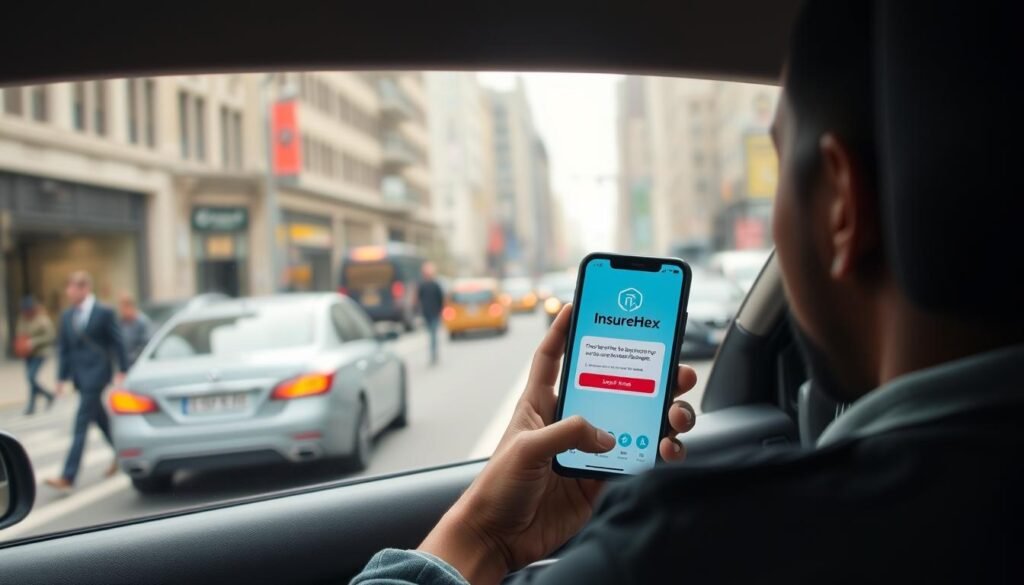
Occupational Accident Insurance
As drivers, we face risks that go beyond what personal auto insurance covers. Occupational accident insurance is a special option for drivers who get hurt in work-related driving accidents. It helps pay for medical bills, lost wages, and other costs from job-related injuries.
This insurance is made for professional drivers. It’s for those who drive for work, like rideshare drivers or truckers. It’s a way to protect your job and finances from the costs of a self-inflicted accident.
Occupational accident insurance offers several key benefits:
- Covers medical costs from work injuries, like hospital bills and rehab
- Helps replace lost wages while you’re recovering
- Protects against claims from accidents you caused, like damage to property or injuries to others
- Can be cheaper than regular commercial auto insurance, especially for work-related incidents
Getting occupational accident insurance gives drivers peace of mind. It’s a key part of a good risk management plan for commercial auto insurance and driver safety insurance.
| Coverage | Occupational Accident Insurance | Commercial Auto Insurance |
|---|---|---|
| Medical Expenses | ✓ | ✓ |
| Lost Wages | ✓ | Limited |
| Liability Protection | ✓ | ✓ |
| Work-related Incident Coverage | ✓ | May be Excluded |
| Potential Cost Savings | ✓ | – |
Knowing the benefits of occupational accident insurance helps drivers make smart choices. It protects their jobs, finances, and health in case of a work-related accident.
Commercial Auto Insurance
Commercial auto insurance is for businesses and people who use their vehicles for work. This includes delivery services, transportation companies, or rideshare drivers. It protects your business assets and reduces risks from using a vehicle for work.
Coverages and Exclusions
Commercial auto insurance offers many coverage options. These include liability insurance, collision and comprehensive coverage, medical payments, and protection for uninsured drivers. Knowing what your policy covers and what it doesn’t is key to protecting your business vehicle.
Eligibility Requirements
- Vehicles used for business purposes, such as delivery, transportation, or ridesharing
- Businesses that own or operate commercial vehicles, including trucks, vans, or specialized equipment
- Individuals who use their personal vehicles for business-related activities, including rideshare driving
- Compliance with state and local regulations regarding commercial vehicle registration and insurance requirements
Getting commercial auto insurance is crucial for your business. It helps protect your business and reduces financial risks from using a vehicle for work. By knowing what your policy covers and who can get it, you can find the right insurance for your business.
| Coverage Type | Description | Typical Limits |
|---|---|---|
| Liability Insurance | Covers damages and injuries to other parties in an accident where you are at fault | $100,000/$300,000/$50,000 |
| Collision Coverage | Pays for damages to your vehicle if you collide with another object | Varies based on vehicle value |
| Comprehensive Coverage | Covers damages to your vehicle from events like theft, vandalism, or natural disasters | Varies based on vehicle value |
| Medical Payments | Covers medical expenses for you and your passengers, regardless of fault | $5,000 – $100,000 |
| Uninsured/Underinsured Motorist | Protects you if you’re involved in an accident with a driver who has insufficient or no insurance | $25,000/$50,000 |
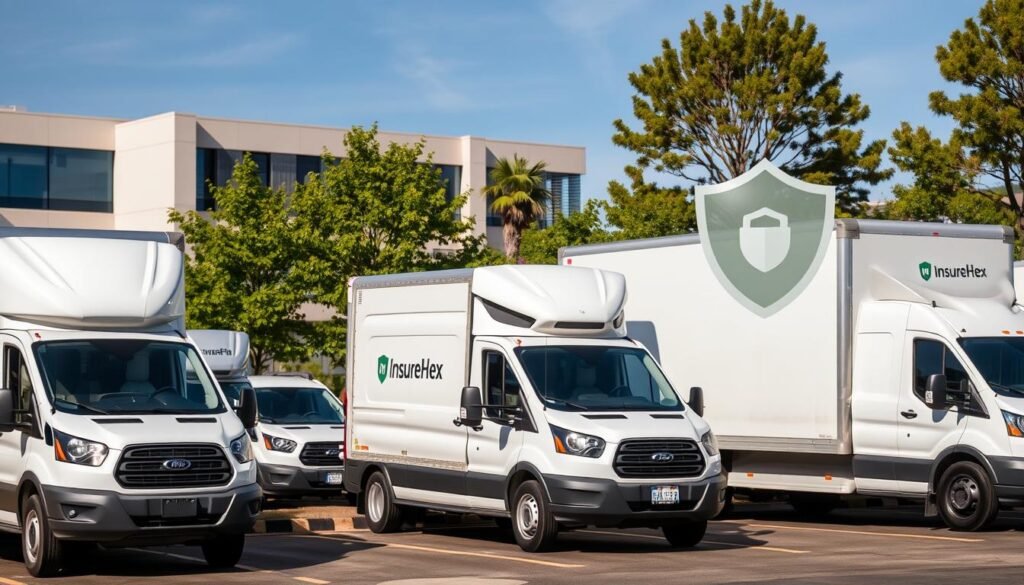
“Investing in comprehensive commercial auto insurance is a critical step in protecting your business assets and ensuring the safety of your drivers and the public.”
Non-Fault Accident Benefits
Car accidents can happen without fault, like hitting an uninsured or underinsured motorist. In these cases, non-fault accident benefits are crucial. They cover medical costs and lost wages. Knowing about these benefits is key to protecting yourself in such accidents.
Uninsured Motorist Coverage
Uninsured motorist coverage is a vital non-fault benefit. It helps pay for medical and other costs if hit by an uninsured driver. Without it, you might face huge financial losses.
Underinsured Motorist Coverage
Underinsured motorist coverage is also important. It helps if the other driver’s insurance is not enough. This benefit ensures you’re not left with all the costs.
Knowing about non-fault accident benefits is essential. It prepares you for unexpected accidents and protects your finances. Exploring these options can give you peace of mind and financial security on the road.
Mitigating Driver Negligence
Having comprehensive insurance is key to protect drivers from accidents they cause. But, taking steps to avoid accidents is just as important. By learning defensive driving and safe habits, drivers can lower the risk of accidents.
Defensive Driving Techniques
Defensive driving means being ready for dangers and avoiding them. It’s about keeping a safe distance, knowing what’s around you, and watching for risks. This way, drivers can handle tough situations better and avoid accidents.
Safe Driving Habits
Safe driving habits are crucial to avoid accidents. Don’t drive distracted by phones or other things. Follow traffic rules, stay sober, and keep your car in good shape. These habits make driving safer for everyone.
“Defensive driving and safe driving habits are not just good practices – they are essential for protecting ourselves and others on the road.”
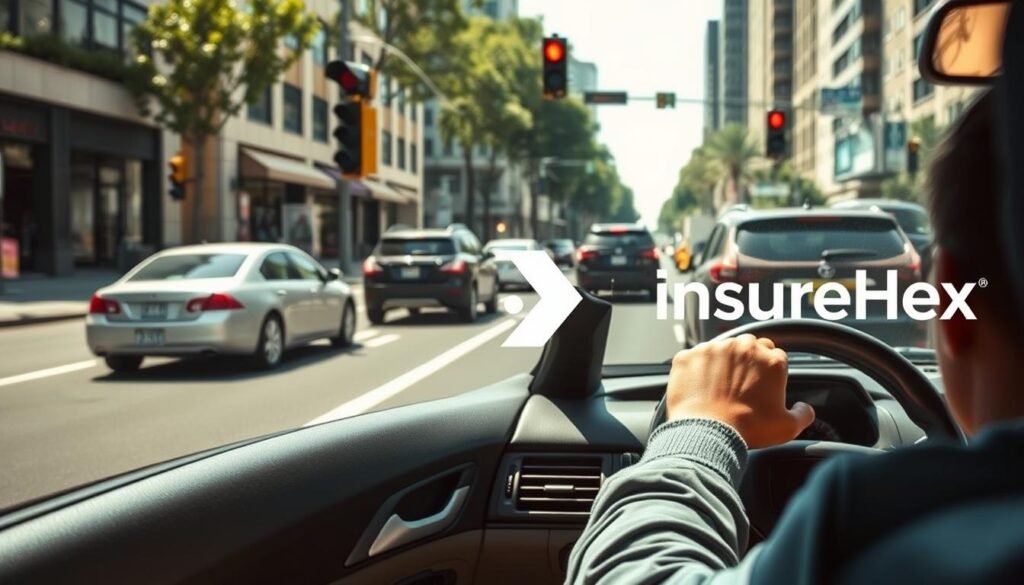
By using these strategies, drivers can lower the risk of accidents. Focus on defensive driving and safe habits. This helps keep everyone safe on the roads.
Filing Claims and Seeking Legal Assistance
After a self-inflicted accident, drivers need to know how to file claims and seek legal help. This process can be tough, but with the right advice, drivers can handle it. They can also protect their rights.
The first thing to do is document the accident well. Take photos, get witness statements, and collect police reports. Drivers should also tell their insurance company all about the accident. This includes when, where, and why it happened.
Insurance companies might deny claims or offer low settlements. If this happens, getting a lawyer can help. A good lawyer can fight for the driver’s rights and make sure they get fair compensation.
Choosing the right lawyer is important. Look for one who knows about self-inflicted accidents and has won cases. They can explain the legal side, guide you, and talk to the insurance company for you.
Knowing how to file claims and when to get a lawyer can help drivers. It can protect them from financial and legal problems. This knowledge is key to getting the support and compensation they need.
| Step | Description |
|---|---|
| 1. Document the Incident | Gather evidence, such as photographs, witness statements, and police reports. |
| 2. File a Claim with the Insurance Provider | Provide detailed information about the accident to the insurance company. |
| 3. Seek Legal Assistance (if necessary) | Hire an experienced personal injury attorney to advocate on the driver’s behalf. |
| 4. Negotiate a Fair Settlement | Work with the attorney to ensure that the driver receives the compensation they deserve. |
Being proactive and informed is key when dealing with claims and lawyers. By following these steps, drivers can avoid financial and legal issues after a self-inflicted accident.
Preventative Measures and Risk Reduction
Insurance and avoiding driver mistakes are key to safety. But, we can do more. Regular car checks, safety feature checks, and driver training help a lot. These steps can really cut down on accident risks.
Vehicle Maintenance and Safety Features
Keeping your car in top shape is vital. Regular checks and oil changes can spot problems early. Also, knowing and using your car’s safety features, like advanced driver assistance systems (ADAS), is important.
Driver Education and Training
Driver education is key to safe driving. It teaches defensive driving and keeps you updated on traffic laws. This knowledge helps drivers avoid dangers and stay safe.
| Preventative Measure | Description | Benefits |
|---|---|---|
| Vehicle Maintenance | Regular check-ups, oil changes, and inspections to ensure optimal vehicle performance and safety. | Identifies and addresses potential issues before they escalate, enhancing overall vehicle safety and reliability. |
| Safety Features | Familiarizing with and ensuring the proper functioning of advanced driver assistance systems (ADAS) in the vehicle. | Leverages technology to anticipate and avoid potential hazards, reducing the risk of self-inflicted accidents. |
| Driver Education | Participation in defensive driving courses and programs to stay up-to-date with traffic laws and regulations. | Equips drivers with the knowledge and skills to make safer decisions and react appropriately in various driving situations. |
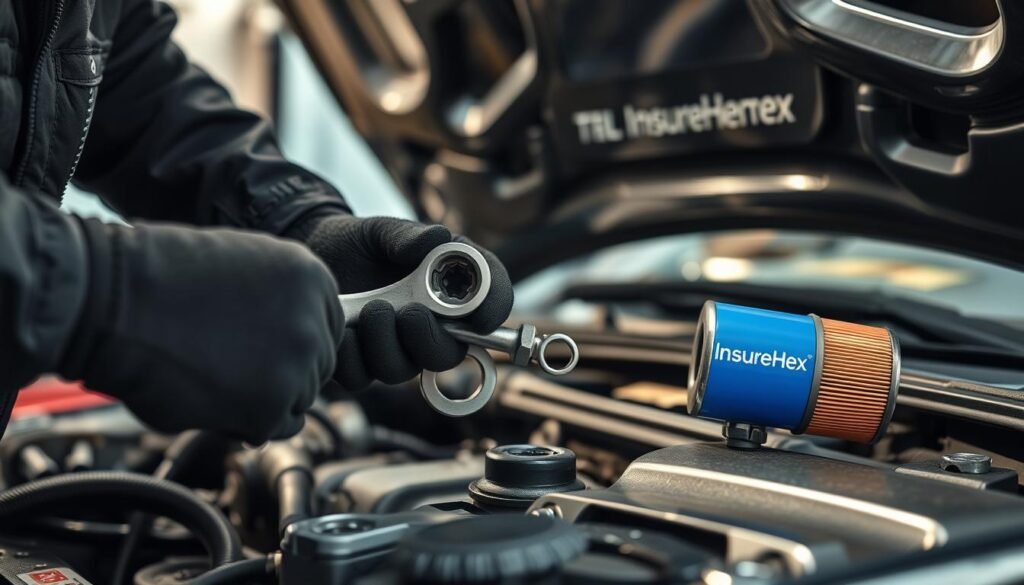
“Proactive preventative measures and risk reduction strategies are crucial in minimizing the consequences of self-inflicted accidents. By prioritizing vehicle maintenance, safety features, and ongoing driver education, we can take a comprehensive approach to enhancing our safety on the road.”
Vacation home insurance: What coverages are important?
Conclusion
Self-inflicted accident insurance is key for drivers. It protects them from financial and legal issues caused by accidents they themselves caused. Knowing the different coverage options and taking steps to avoid accidents is important.
Understanding personal injury protection and other coverages is crucial. We also need to know about rideshare and commercial auto insurance. This knowledge helps us make smart choices and stay safe on the road.
Driver safety is a top priority. Using defensive driving and keeping our vehicles in good shape can lower accident risks. If an accident does happen, knowing how to file claims and get legal help is vital. This ensures we get the support and compensation we need.

